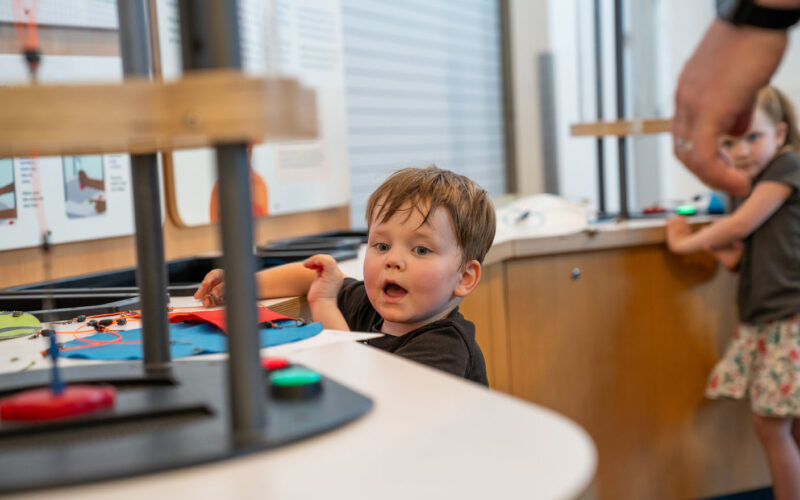MONICA HOOPER
mhooper@nwaonline.com
Did you know that a creature as tiny as an ant taught architects better ways to keep skyscrapers cool? That the shape of a kingfisher’s beak inspired the design for bullet trains? Or that the albedo (the white part of citrus fruits) inspired the construction of bike helmets?
It’s all part of biomimicry — how people use ideas that they find in nature to solve human challenges. Kids and families are invited to explore these concepts and more in “Creatividad Silvestre | Wild Creativity,” the latest traveling exhibit at the Scott Family Amazeum in Bentonville.
“We’re seeing a lot of kids get in there and get their hands dirty and really trying to learn,” says Kaley Wyckoff, marketing and communication coordinator for the Scott Family Amazeum. “Even parents are getting in there and learning things.”
The Spanish-English traveling exhibit from the Oregon Museum of Science and Industry contains 10 hands-on exhibits including a Skee-Ball style game that mimics the way a flea hops onto a horse, a dog or a cat. Another game allows kids to explore the way a kangaroo saves energy yet hops faster and higher — much like you might bounce on a trampoline. The real fun is trying to score a goal using gravity, speed and aim in the same way animals do.
“It’s cool to be able to still learn things,” says Wyckoff. She admits that she didn’t know that designers studied shark skin to create better swim suits for people before the traveling exhibit landed at the Amazeum.
Two of the largest exhibits in “Creatividad Silvestre” — which has Spanish descriptions at the top and English on the side — allow guests to explore energy making and impact. Regular Amazeum visitors will recognize the self-contained wind tunnels from similar exhibits in the museum, but this interactive feature explores creating energy using handmade kites modeled on flying squirrels and bird wings. Another exhibit lets kids create shock absorption using foam and materials similar to the sponge inside layers of a pomelo or the tissue in a cat’s paw.
A touch screen lets the user build a rooftop garden on an interactive display that informs you about the best grouping for your crops based on facts given about each plant.
Kids may also create their own designs with prompts from worksheets and display them for other Amazeum visitors as part of the exhibit.
Wyckoff estimates that the intended ages are 4-14, but children as young as 2 enjoy playing with some of the hands-on exhibits.
“We just see lots of different people come in and enjoy it,” says Wyckoff. “One of our main, guiding principals is to keep kids curious and keep them learning through play. We want them to have fun. We want them to learn to love to learn.”
—
FAQ
‘Creatividad Silvestre | Wild Creativity’
WHAT — Ten interactive, Spanish-forward traveling exhibits which allow kids of all ages to explore biomimicry, how people are inspired by nature to solve problems.
WHEN — Through Sept. 2
WHERE — Scott Family Amazeum in Bentonville
COST — Included with $14 general admission or free with Amazeum membership
INFO — amazeum.org
FYI — 4:30-7:30 p.m. every Wednesday is pay-what-you-can Priceless Night at the Amazeum. Adult Night: Amazeum STEAM Olympics will begin at 6:30 p.m. June 27.



